This is a Ricoh FF-90 Super, an advanced and fully automatic 35mm point and shoot camera made by Ricoh Co., Ltd in 1987 The Super is a slight upgrade to the original FF-90 from two years earlier, and was very popular in it’s home country of Japan as a premiere compact camera. It has a 5-element f/2.8 Ricoh lens which meant it compared favorably to higher spec offered by Nikon and other competitors. On the top plate was a huge LCD display which provided the user info about the cameras various settings. Overseas the FF-90 Super was sold under various names, including the FF-700, FF-300D, and Myport 300D.
Film Type: 135 (35mm)
Lens: 35mm f/2.8 Ricoh coated 5-elements
Focus: 2.6 feet to Infinity with infinitely variable Auto Focus
Viewfinder: Straight through with 35mm Projected Frame Lines
Shutter: Metal Blade Leaf
Speeds: 2 – 1/500 seconds, stepless
Exposure Meter: Silicon Photo Diode photocell with Programmed Auto Exposure
Battery: 6v Lithium 223 or BR-P2 Battery Pack
Flash: Integrated Flash with Manual Override
Manual (similar model): https://www.butkus.org/chinon/ricoh/ricoh_ff-90/ricoh_ff-90.pdf
My Thoughts
Point and Shoot Auto Focus cameras from the 1980s rarely get much attention from collectors. Sure, there are exceptions like the Nikon L35AF with it’s 5-element Nikon lens, Canon AF35ML with a huge f/1.9 lens, and the various Yashica T-series cameras with Carl Zeiss Tessar lenses who all consistently draw praise and high prices on the used market. Aside from these exceptions, most point and shoot auto focus cameras are nothing more than throwaways to be found in the bargain bins of Goodwill stores all across the country.
One day, I read a discussion among fellow collectors about a Ricoh AF-5 and how it compared favorably to other highly regarded point and shoots of the era. Ricoh wasn’t a brand I was hugely familiar with, so I did my own research for other undiscovered gems and that’s when I learned about a model called the FF-90. I thought it to be an abnormally handsome camera, especially considering it’s age. I assumed this had to have been a late 80s or even 90s camera, but was shocked to learn that it was released in 1985. Even more shocking was that I saw it had a 5-element lens, similar to that found in the original Nikon L35AF.
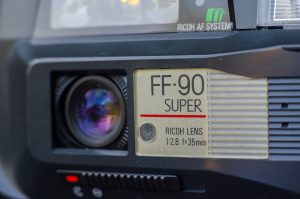
A quick search on eBay and I found a small handful for sale, all at bargain basement prices and I thought what the heck. As it turned out, there were two different FF-90 models, the original, and one called the FF-90 Super which is the one reviewed here. The FF-90 was released in 1985, but the FF-90 Super was released in 1987 and had the following changes:
- Uses 6v Lithium Battery instead of two AA batteries
- Added support for electronic remote shutter release
- Added ability to override DX-encoded film speed settings
- Revised styling
The changes weren’t significant, and although the 6v Lithium battery would allow the camera to go much longer without having to be replaced, the 223 style of battery needed for the Super is quite expensive, especially when compared to run of the mill AA batteries. The camera doesn’t look significantly different, but I think the changes further improved the good looks of the camera.
Without a doubt, the first thing that will draw attention when you first look at the FF-90 is the huge LCD display on top of the camera. Although by 1987 when this camera was introduced, LCD displays weren’t new, to have one this large and prominent must have seemed futuristic. A large portion of the LCD display is taken up by a cartoonish graphic showing film advance from one circle to another. This serves two purposes, it lets you know that film is indeed loaded in the camera, but just in case the loud sounds of the film advance motor weren’t enough, the display is animated any time the film is advancing or rewinding.
Other things that the LCD display can show are:
- Total exposures on roll (DX detected) and exposures made
- Detected DX film speed, or manual override setting
- Battery charge indicator (blinks when low)
- Lens shield readiness indicator
- +2 EV indicator
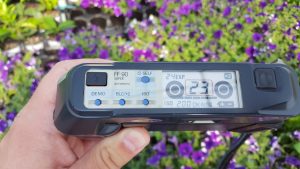
To the left of the LCD display are 4 small buttons that are recessed into the top plate to prevent accidental pressing, and a large popup Flash button that automatically pops up any time the camera detects the flash is needed. You can press this button back down to override the flash if you so wish. You can also trick this button into popping up by covering the photocell on the front of the camera and half pressing the shutter release down. This is useful when you want to use the flash as a fill in brightly lit scenes.
The 4 other buttons are to activate a 10-second Self Timer, changing ISO film speeds, activating the +2 EV back light mode, and a strange Demo button which shows all of the animations the LCD is capable of. Interestingly, the Demo button only exists on the FF-90 Super, on the non-Super model, it’s called the Display button, but it performs the same function.
Beyond the top plate the only other things that you need to know about in this camera is the flash readiness indicator that is conveniently located next to the rear viewfinder, the rewind button located on the bottom of the camera, the integrated lens cap/lens readiness switch immediately below the lens (which also deactivates the shutter when closed), and the LCD self timer LED on the front of the camera, next to one of the viewfinder windows.
The FF-90 Super, like most 1980s point and shoot cameras isn’t exactly small. While small enough to fit in a large coat pocket, it would not fit in any shirt pocket I’ve ever seen. The camera is sufficiently narrow front to back, and its not very tall, but it is extremely wide. This is likely a side effect of the large battery compartment on the left side of the camera. Weighing in at 347 grams with a battery but no film installed, the camera is considerably lighter than a Canon AF35M at 425 grams and a tad heavier than a Nikon One Touch AF3 weighing 318 grams.
In terms of ergonomics, the width of the camera allows for a small hand grip on the right side of the camera. The grip is neither big nor small, it was just the right size for my medium sized hands. When gripping the camera with your right hand, your left index finger falls exactly where the shutter release is. The back of the camera has various curves and textures to further improve handling. While shooting, I found the FF-90 Super to be comfortable to hold and operate.
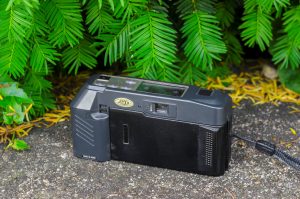
The viewfinder is slightly off center to the right which is contrary to most cameras where it’s either dead center, or off to the left. For those of you who are left eye shooters like me, this might trip you up if you instinctively bring the left side of the camera to your left eye. I found that I would have to re position the camera often when bringing it to my eye. This could possibly be a plus for right eye shooters, but I can’t really say.
The viewfinder itself is on par with the size and brightness of other cameras of the 1980s. I would have preferred a slightly larger one, but as it is, I can’t really complain. Inside is the 35mm projected frame lines with parallax hashes indicating the view at close focus.
In the center of the viewfinder is the auto focus frame. Like most other AF cameras of the 1980s, the FF-90 Super can only detect focus in the center of the frame. Multi-point auto focus systems were still a couple of years away in the point and shoot segment. If you would like to compose an image where the focal point is not in the center, you must pre-focus using this square and half press the shutter, and then while still holding the shutter halfway down, recompose your image and then press the shutter the rest of the way to complete the photograph.
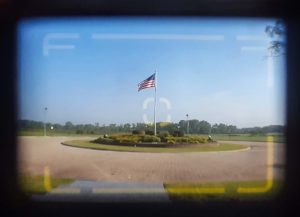
On the left side of the viewfinder are 3 icons indicating Portrait, Group, and Landscape distances. A red LED will illuminate indicating which distance the camera has detected. If the auto focus sensor has detected a subject closer than the minimum 2.6 feet distance, the Portrait icon will flash and you will not be able to fire the shutter. The image to the right is of the FF-90 Super’s viewfinder. You can see the projected frame lines and center focus location, but due to how I capture these images with my cell phone, I was unable to get the three icons on the left side of the viewfinder. So, although you can’t see them in this image, trust me, they’re there!
It’s worth noting that having a Portrait, Group, and Landscape icon in a 1980s auto focus camera is pretty typical, but unlike other AF cameras of the era, the FF-90 Super can infinitely focus the lens from the minimum focus distance all the way to infinity. This is unlike the more primitive systems found in competitor’s cameras where the AF system can only zone focus in groups. If the FF-90 Super detects your subject is 7 feet away, it will focus to 7 feet, if it detects your subject is 11 feet away, it will focus to 11 feet. This should result in more correctly focused shots.
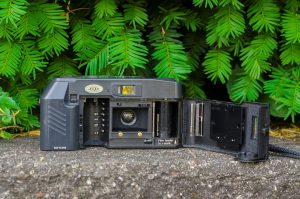
In an article that appeared in the August 1985 issue of Popular Science, Ricoh vice-president Ray Ohannes was quoted as saying the FF-90 was designed to offer “the best that modern technology can provide.” I’d tend to agree with that statement, especially when comparing it to it’s competition. The FF-90 would never take the place of a modest SLR of the era, but when compared to other auto focus point and shoots, there was a lot to like. For one, the 5-element lens was extremely uncommon. Nikon offered a 5-element in their original L35AF from 1983, but by 1985 had been replaced by a 4-element lens in their next model. The highly regarded Carl Zeiss lenses offered in the Yashica T-series cameras were all 4-element Tessar designs. Even Ricoh’s other lines of auto focus cameras had 4-element lenses, so it was quite special to have something like this still available on the market when the FF-90 Super was released in 1987.
In addition to everything I’ve already mentioned above like the stepless auto focus system, the +2 EV backlight mode, the large LCD screen, and the integrated lens shield, there are few other nice details that at first glance aren’t immediately obvious. For one, the takeup spool has a slightly grippy rubberized coating on it which helps “catch” the film leader when loading. Although the FF-90 already offers a simplified film loading design, this grippy surface all but guarantees a properly loaded roll of film every time. Also, when rewinding the film at the end of the roll, the camera leaves the film leader out of the camera. This was a feature common on mid to high end SLRs of the day, but I cannot think of any other automatic point and shoot camera that will do this. This is especially useful if you wish to rewind a partially exposed roll of film and finish it in another camera. Take note of how many exposures you’ve already shot, rewind the film, remove it from the camera, put it in another camera, and advance the film to the next unexposed frame.

Another little feature that’s not even mentioned in the manual, is that the camera must have some type of internal capacitor to keep the camera’s memory alive for a few minutes after removing the battery. This allows you to swap out a dying battery for a fresh one without losing any of your settings. I noticed this after removing the battery and I saw the LCD screen was still powered on for several minutes after.
Finally, the FF-90 Super still features a tripod socket on the bottom of the camera which is something that was quickly disappearing from point and shoot cameras by the 1980s. This would come in handy to take advantage of the camera’s maximum 2 second slowest shutter speed.
My Results
Point and shoot cameras are at their best with candid and spontaneous shots, so I loaded in a roll of Fuji 200 and left the camera on my desk for me to pick up and go whenever I was going somewhere. I wound up shooting a majority of a roll at a White Sox baseball game, but also took it on a trip downtown Chicago and while walking around my neighborhood looking at flowers. I figured I might as well review the camera using it in a manner consistent with how a target customer of this model would have.
Most people assume that point and shoot cameras have some level of compromise compared to more capable rangefinder and SLR models. There’s a reason that people spend more money on interchangeable lens cameras than fully automatic point and shoot models like this. So when I review images shot with a camera like the FF-90, I look for things that maybe I wouldn’t have been happy with on a more capable camera and adjust my expectations accordingly.
Reviewing the roll from this camera, there was a bit of good, and a bit of not so good. There were two minor issues that I didn’t expect, one being that many of the images seemed a bit more washed out than I typically get from Fuji 200, but also that several of the images were a tad overexposed. Both issues may be related as overexposing color film does have a tendency to wash out colors.
The film I used was fresh, and since the camera uses DX encoding, there’s no chance that I set the film speed correctly, so why weren’t these images perfectly exposed 100% of the time? It’s worth mentioning that compared to cameras I normally review, the FF-90 is practically brand new, but brand new in camera years, is still 30 years in regular time. So, I’ll at least consider the possibility that something is off with the camera’s meter.
The 5-element lens is definitely sharp. Details are extremely crisp and detailed throughout the entire frame. I noticed no softening near the edges of corners suggesting the lens resolves details as good as other much more valuable 5-element lenses such as those found in the Nikon L35 or the 4-Element Tessar found in the Yashica T-series point and shoots. The lens isn’t perfect however, as there is a bit of vignetting visible near the edges. The vignetting is evident in almost every image in the gallery above, especially the one of the baseball field shot from above.

The auto focus wasn’t perfect either. The first instance of this in the gallery above is of the purple flowers. I intentionally shot this at an angle of a repeating pattern of flowers to see what the camera would select, and it seems to have missed the center of the frame. Another example is the image to the right of me holding up a beer can. I clearly have the can in the center of the image where the focus sensor should have detected it, but as you can see it is clearly not in focus. I’ll at least consider that possibly the length of my arm is not long enough to have placed the can beyond the camera’s minimum focus distance of 2.6 feet. I am pretty sure my arms are longer than that but I guess it’s possible I just tricked the camera. As you can see though, the rest of the images are correctly in focus, so for an autofocus camera from 1987, I’ll still say that the auto focus sensor did a pretty decent job.
Overall, the Ricoh FF-90 Super was a surprisingly nice camera that is worth a look if one ever crosses your path. It is clear that Ricoh tried hard to come up with some features that weren’t common for point and shoot cameras of the day. The 5-element lens is quite sharp, the top LCD panel is neat, and I appreciate the features like leaving the film leader out of the cassette when rewinding and the ability to override the DX film decoding. My issues with washed out colors, slightly overexposed images, and a few auto focus misses might be a result of the age of the camera, or they could have been there all along, I have no way of knowing.
Ricoh aimed a little higher than just a cheap plastic camera and mostly delivered. Does this mean the FF-90 Super belongs on the pantheon of legendary point and shoot cameras of the day? I can’t really say, because quite simply, if you want a good 35mm film camera from the 1980s, there’s a ton of better options than ANY point and shoot camera.
My Final WordHow these ratings work |
The Ricoh FF-90 Super is a relatively unknown point and shoot camera made by Ricoh in the mid 1980s. It is a better than average model featuring a really nice 5-element lens, a large and informative LCD panel on the top plate of the camera, and several features like DX film override and the ability to leave the film leader out when rewinding film, which were’t common on most point and shoot cameras of the day. In use, the camera works as expected and mostly delivers excellent shots. For the rare person who collects and shoots fully automatic cameras from the 1980s, this is definitely a model you should consider. Since these are relatively unknown to most collectors, they often get thrown in with cheap $1 cameras at the thrift store. If you ever come across one in working condition for that price, I think you’d be quite pleased. | ||||||
| Images | Handling | Features | Viewfinder | Feel & Beauty | History | Age | |
| 1 | 1 | 2 | 1 | 1 | 0 | 0% | |
| Bonus | none | ||||||
| Final Score | 6.0 | ||||||
Additional Resources
http://camerapedia.wikia.com/wiki/Ricoh_FF-90
http://www.35mmc.com/01/08/2013/ricoh-ff90/
https://www.35mmc.com/25/05/2018/ricoh-ff-90-super-review/
http://www.stevehuffphoto.com/2014/07/22/my-3-wonder-the-classic-ricoh-ff-90-review-by-brandon-huff/

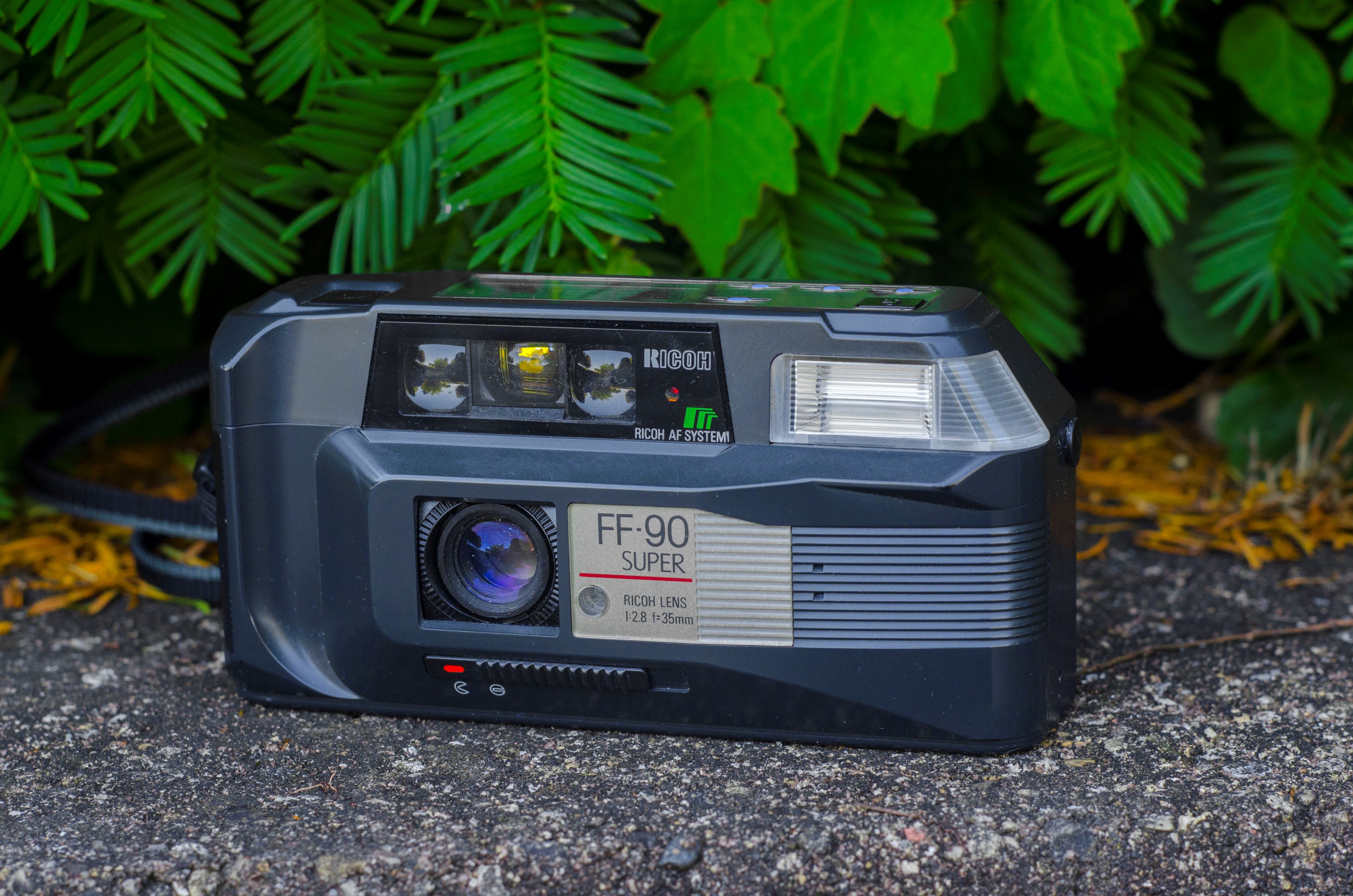
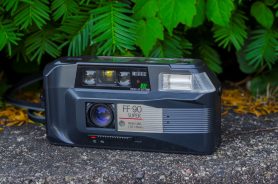
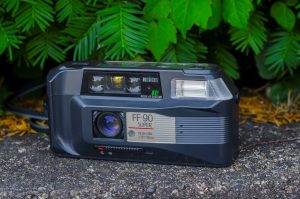









So I know this is an old post, but according to the user manual, the ff-90 super/ff-700 has the same 10 step autofocus system that the ff-90 has. It can focus to infinity as you point out here, but it’s limited to 10 steps (or zones) in between. That’s better than a lot of early autofocus cameras, but it’s not a categorically different mechanism.